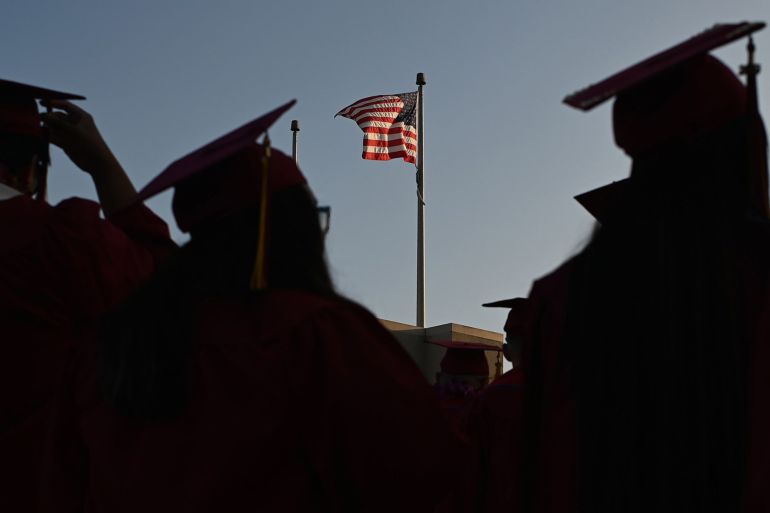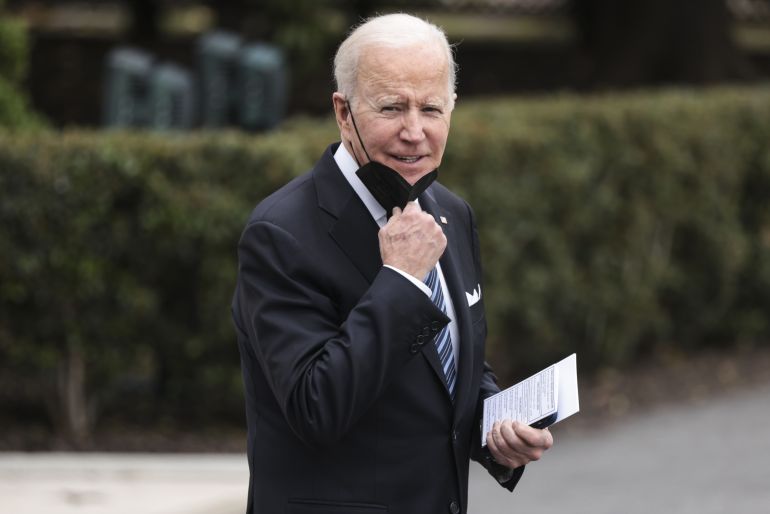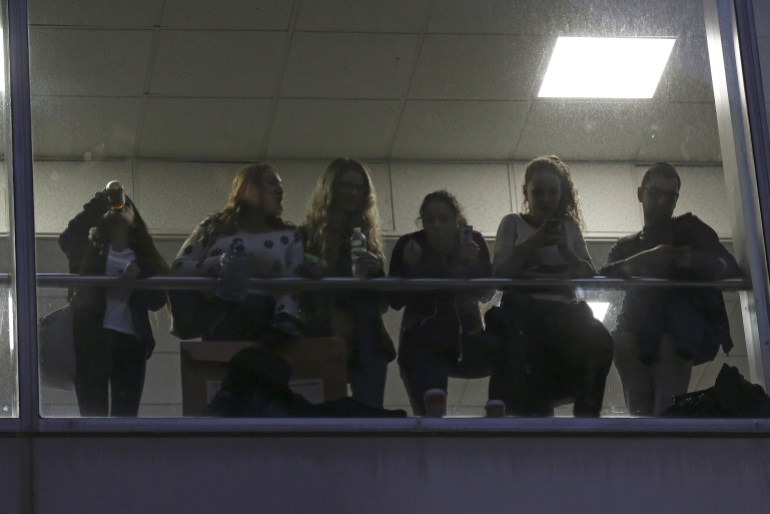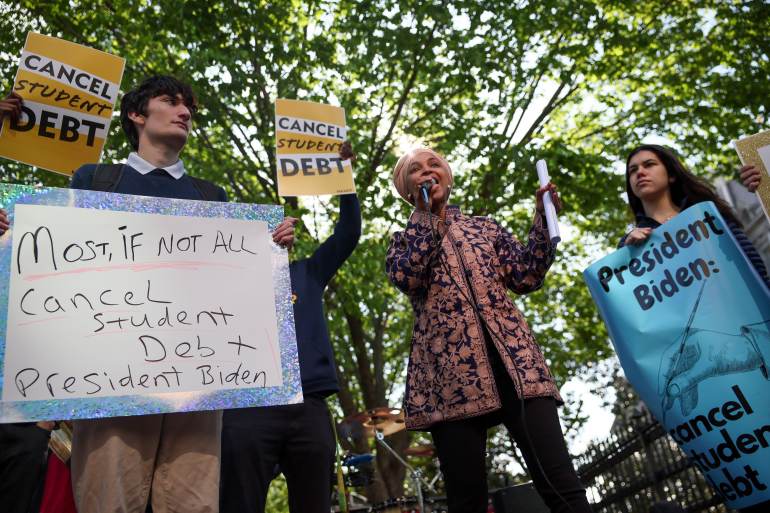‘I feel stuck’: Inside the growing US student debt crisis
With the pause on student loan payments expiring at end of August, will Joe Biden give borrowers a break and extend it?

New York, US – Dara Zucker says she’s stuck. The 28-year-old has been making monthly payments on her student loans since she graduated with a degree in psychology from Kenosha, Wisconsin’s Carthage College in 2016, but her balance has only gone up.
“I feel stuck in my life,” she told Al Jazeera, about the $39,000 she still owes on her $35,000 loan.
Keep reading
list of 4 items‘Uncharted territory’: Five key takeaways on US inflation
Five things to know about the next US housing crisis
The Great Resignation is spawning a talent war. Who will win it?
And Zucker is not alone – Americans owe nearly $1.75 trillion in student loan debt, an increase from $481bn in 2006, according to the Federal Reserve Bank of St Louis, the highest level of student debt in the world.
As the country’s student loan debt crisis deepens, borrowers, policymakers, and economists agree that something must be done – but what exact steps need to be taken remains up for debate.
At the onset of the COVID-19 pandemic, the Trump administration halted student loan interest and later suspended loan payments as lockdowns spurred mass layoffs and business closures. President Joe Biden, who campaigned on a promise to “immediately cancel a minimum of $10,000 of student debt per person”, has repeatedly extended that moratorium.
However, the payment freeze expires at the end of August, and unless Biden extends it, 45.4 million student loan borrowers will be expected to resume monthly loan payments on September 1. The average monthly student loan payment in the United States is $393.
Zucker, who says that she used the pause in payments to help her disabled parents buy groceries, just received a promotion and raise at the background check company where she works as a business development representative. But the raise also means her salary-dependent, monthly student loan payment will double to $220 when payments resume.
“I’m grateful for my job and salary,” she said in an interview. “But the fact that I can make my payments and still can’t live my life as an adult by buying a house or having a wedding – I just can’t do those things.”
‘The big picture’
American tuition at public four-year universities climbed 31.4 percent between 2010 and 2020, the Education Data Initiative research group found. Tuition in many other countries is either fixed or fully free, as in Germany, Iceland, and Sweden. A year of college at a four-year US university costs $35,551 on average, including tuition, fees, on-campus housing, books, supplies, and other expenses, according to the National Center for Education Statistics.
The colleges to which a student applies determine how much financial aid they are eligible for, depending on the cost of attendance and the family’s ability to contribute towards tuition and fees. The student may be eligible for federal grants, subsidised loans, and work-study. The student can then apply for a loan to finance the remainder of the costs.
The federal government doles out the majority of the loans, with the private sector lending the remaining 7 percent. Borrowers are then required to begin making payments six months after leaving college, whether they graduated or not.
Several economists Al Jazeera interviewed said that universities and the higher education industry at large need to do a better job of informing students about the debt they are taking on and what it looks like to enter various types of repayment programmes after graduation.
For example, the income-driven repayment plan in which Zucker is enrolled, allows borrowers to make payments depending on their salary, but it also lengthens the duration of the loan and adds extra interest to the total.
“I think we’ve put young people in a really tough position,” said Cristian deRitis, a leading economist at Moody’s, a New York-based research firm. “‘A lot of young people don’t have the big picture of what incurring this burden actually means or they dream about making six-figure salaries right out of college.”
A recent study found that US college students believe they will make roughly $103,880 in their first job. The average starting salary for college grads, however, is $55,260.
According to the Federal Reserve Bank of New York, Americans are increasingly dependent on credit cards to make ends meet, amassing $46bn in the second quarter of 2022, the largest credit card balance year-over-year percentage gain since 1999. Meanwhile, households have begun to deplete the excess funds they amassed during the pandemic, according to Goldman Sachs, as the national inflation rate soars.
“I would expect certain delinquencies to rise quite soon,” said deRitis. “Many of the people who were already in a difficult spot when they hit the pause button during the student loan moratorium will most likely return to delinquency.”

‘The debt doesn’t just disappear’
Zucker, who said she supported Biden because she believed he would cancel part of her college debt, told Al Jazeera she wants the president to make good on that promise and then some.
“He should also cancel all student loan interest and suspend it on all current paying accounts, then take the total amount paid by all of these students, including myself, and deduct it from their initial loan balance,” she said.
According to the analytics firm MeasureOne, the federal government currently originates and services 93 percent of all student loans. This means that the US government is the primary lender of student loans, and that the loans are held by the American taxpayer. As a result, when loans are defaulted on or forgiven, that cost is passed on to the federal taxpayer.
Student loan forgiveness, according to Lindsey M Burke, director of the Center for Education Policy at the Heritage Foundation, a conservative think-tank in Washington, DC, is a problematic policy for a variety of reasons.
“Everybody suffered during the pandemic,” Burke said. “College graduate degree holders were least likely to be unemployed and most likely to be able to work from home, so this idea that we’re going to give them loan forgiveness when so many others fared much worse, it’s just political.”
The debt does not just disappear, Burke said. For American taxpayers, student loan forgiveness may mean higher taxes or more inflation, she argued, adding that it may also translate to greater costs down the road. “The current class of students are going to take on more debt than they would have or attend more expensive colleges in the hopes that their loans may be forgiven in the future,” she said.
But those arguments were rejected by Sabrina Calazans, outreach coordinator at the The Student Debt Crisis Center (SDCC), a non-governmental group based in Los Angeles, California, which is lobbying for at least $50,000 in student debt cancellation per borrower.
“Forgiving $10,000 right now would provide immediate relief to millions of Americans,” Calazans told Al Jazeera. “We’re not asking for a handout. Some people have paid their balance in full but they can never pay it off because of the accruing interest.”

Private versus public
Moody’s deRitis said more can be done to mitigate how loans are made available.
“You could argue perhaps the US government should restrict and not lend more than a certain amount. Let’s say you get to borrow up to $30,000 or decide to go to a lower-cost school or take on additional jobs,” he told Al Jazeera.
Burke of the Heritage Foundation argued that the private lending market would do a better job at differentiating interest rates based on what a student wants to major in, their credit worthiness, whether they have a cosigner and how well they have done in high school.
“There are a lot of measures that the private market could take into account that the federal government as the lender can’t and really shouldn’t,” she said. “We want the private sector to send signals to students about the efficacy of what they plan on studying and about what fields would provide them with a solid career moving forward.”
But Calazans of SDCC said that if the private sector employs credit ratings and co-signers to assess loan eligibility, low-income people may be denied entry to higher education. It would also make it difficult for borrowers with no credit, such as young people, immigrants and others excluded from the banking system, to go to college.
Furthermore, private student loans do not have nearly the same consumer protections, repayment programmes, or options available to defaulted borrowers, making it more difficult for struggling borrowers. “As a borrower myself, I have both federal and private loans and I have a private loan with a 13 percent interest rate. We need to make interest rate changes to the current payment plan and the wider student loan system, not privatise loans,” she added.

‘Your student loans, they stay with you’
Calazans said young people in the US who want to further their education face difficult choices.
“They’re saying, ‘I’m not going to college because I don’t want to take on thousands of dollars in debt and not be able to afford to buy house or do anything else down the line.’ And the ones who borrowed are saying ‘my debt-to-income ratio is so high that I can’t buy a house or help my children invest in their future’. So it really becomes this ugly cycle.”
Zucker, the psychology graduate, said it did not take her long to understand one very important thing: Student loans are unlike any other debt in the US.
“I think people blur the line and say, ‘Oh, well, if we’re forgiving student loans, then we need to do this or that with mortgages and medical bills.’ And I say, no, you don’t get it. It’s not the same thing,” she said.
“You file for bankruptcy, your student loans: They stay with you.”